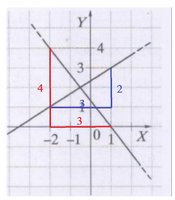Any (non-vertical) line can be written in the form y= ax+ b for some numbers a and b. Looking at the graph I see one line that contains the points (-2, 1) and (1, 3). That means that if x= -2, y must be 1 so that 1= a(-2)+ b, and that if x= 1, y must be 3 so 3= a(1)+ b.
We have the two equations to solve for a and. We can eliminate b by subtracting one equation from the other: 3- 1= a(1- (-2))+ b- b so 2= 3a, a= 2/3. Then 3= 2/3+ b, b= 9/3- 2/3= 7/3.
The first line is give by y= (2/3)x+ 7/3. Check: when x= -2, y= -4/3+ 7/3= 1 and when x= 1, y= 2/3+ 7/3= 9/3= 3. If we don't like fractions we can multiply both sides by 3 and have 3y= 2x+ 7 or 3y- 2x= 7.
The second line contains the points (-2, 4) and (1, 0). Those give us the two equation 4= a(-2)+ b and 0= a(1)+ b. Subtracting the second equation from the first 4- 0= 4= a(-2- 1)+ b- b or 4= -3a so a= -4/3. Then 0= (-4/3)+ b so b= 4/3.
The equation is y= (-4/3)x+ 4/3. Check: when x= -2, y= (-4/3)(-2)+ 4/3= 8/3+ 4/3= 12/3= 4 and when x= 1, y= -4/3+ 4/3= 0/3= 0. This can also be written 3y= -4x+ 4 or 4x+ 3y= 4
Assuming the graphs are drawn correctly, this is NOT a "close approximation", it is exactly right.
We can also use those to determine exactly where the two lines intersect. We have 3y- 2x= 7 and 4x+ 3y= 4. Subtracting the second equation from the first eliminates y: -2x- 4x= -6x= 7- 4= 3. x= -3/6=-1/2 so y= (-4/3)(-1/2)+ 4/3= 2/3+ 4/3= 6/3= 2. The point of intersection is (-1/2, 2) which is what the graph shows.

